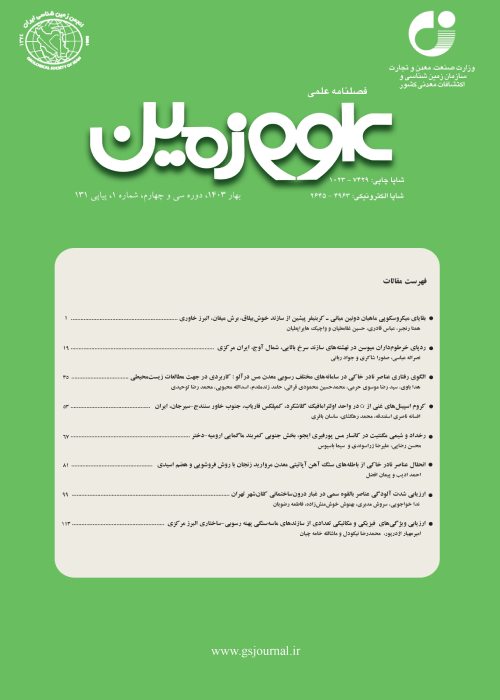Sedimentological Characteristics and Origin of Urmia Lake Deposits Along the Shahid-Kalantari Highway
Author(s):
Abstract:
The hypersaline Urmia Lake is the most important intra-continental environment in Iran, with distinctive geological, environmental, and biological, characteristics. The Shahid-Kalantari Highway (under construction) between Urmia and Tabriz cities passes through this lake. Some 14 km dyke is constructed in the lake for this passage and about 1400 meter is left for a bridge construction. The role of the constructed dyke on sedimentation pattern seems significant, as understood from satellite images and field observations. This study deals with sedimentological characteristics and origin of deposits along the Shahid-Kalantary Highway of Urmia Lake. Availability of 4 cores from boreholes drilled for geotechnical studies provided a good opportunity for this study. This study is carried out on the cores of the 4 boreholes (340 m thick in total) and samples collected from the sea floor along the dyke. Mineralogical, textural and structural characteristics of the sediments were studied for determination of chemical, biological and physical processes responsible for their development. Some 396 plugs from the cores (0.7 to 1 m interval) and 15 samples from the sea floor (cores of 20-40 cm long) were selected for these purposes. To investigate the role of surrounding rivers in providing detritus material to the study site, samples from suspension load of the major feeding rivers are collected. Major characteristics of these samples are studied and compared with those from the study area. All available data on the discharge and sediment load of the major feeding rivers are collected and analyzed for this study. Size and shape are two major textural characteristics investigated in this study using petrographic methods (including SEM). Chemical composition of sediments is studied by petrographic (coarse material) and XRD (fine material and clay minerals) methods. Organic mater, carbonate content, and evaporate portion of the sediments are measured using standard techniques introduced in the literature. Results from this study shows that 25 to 40 % of the studied sediments are derived from the land, through feeding rivers and 60 to 75 % of them are formed within the basin by chemical and biological processes. Quartz, feldspar, volcanic lithics, heavy minerals including pyrite and pyroxene, and clay minerals are major detrital constituents of the sediments. Kaolinite, illite, and montmorillonite are common clay minerals in the sediments, which characteristics are similar to those determined in the suspension load of feeding rivers. Some carbonates, as carbonate lithics, and organic material are also found detrital in origin. Gypsum, halite, calcite, and aragonite are the chemical components of the sediments occur as evaporate and mud crusts, or coated grains. Fecal pellets and some coated grains (produced by algae) are the main biological components of the studied sediments. Pyritization of pellets, especially in lower parts of the cores, is commonly observed, so that, pyrite is presented in the sediments both in detrital and diagenetic forms. Distribution pattern of the major constituents along the studied cores reflect the significant role of sea level fluctuation in their development. Results from this study show that the chemical components of sediments developed during the stages of sea level fall, during which the sea was barely receiving sediments from the land (dry periods). The coated grains of this origin were developed in the basin margin, where the wind-induced waves produced a relatively high energy sub-environment in the margin. The biological constituents of the sediments were developed during sea level rise (lower salinity conditions), during which environmental conditions were not suitable for development of chemical sediments. The origin of detrital material is related to the feeding rivers. TalkeRud in the eastern part of the sea had a major role in providing coarse terrigenous particles to the basin. Major characteristics of the detrital quartz, feldspars, pyroxene and volcanic lithics are similar to those find in the volcanic outcrops of the Islami Island and TalkeRud alluvial fans. The Shahr Chay, Nazlu Chay, and Barandoz Chay in the west and ZarinehRud and SiminehRud in the south had significant role in providing fine terrigenous (clay minerals) to the studied area. On the basis of distribution pattern of terrigenous sediments and their ratio to chemical and biological sediments, the feeding rivers around the lake (major suppliers of the terrigenous sediments) are classified into three groups (most, moderate and low effective). This is designed for further investigation on the controls of sediments accumulation along the highway. This study emphasizes on more significant role of chemical and biological processes on the sediments accumulation in the studied area, than that of physical processes. Due to significant role of sea level fluctuation in chemical and biological sediments development, a thorough control on sea level fluctuation (dam construction, artificial evaporation for salt acquisition, and etc.) is vital in this basin. In this regard any program for sedimentation control along the dyke must take greater consideration on chemical and biological deposition.
Language:
Persian
Published:
Geosciences Scientific Quarterly Journal, Volume:19 Issue: 74, 2010
Page:
57
magiran.com/p801763
دانلود و مطالعه متن این مقاله با یکی از روشهای زیر امکان پذیر است:
اشتراک شخصی
با عضویت و پرداخت آنلاین حق اشتراک یکساله به مبلغ 1,390,000ريال میتوانید 70 عنوان مطلب دانلود کنید!
اشتراک سازمانی
به کتابخانه دانشگاه یا محل کار خود پیشنهاد کنید تا اشتراک سازمانی این پایگاه را برای دسترسی نامحدود همه کاربران به متن مطالب تهیه نمایند!
توجه!
- حق عضویت دریافتی صرف حمایت از نشریات عضو و نگهداری، تکمیل و توسعه مگیران میشود.
- پرداخت حق اشتراک و دانلود مقالات اجازه بازنشر آن در سایر رسانههای چاپی و دیجیتال را به کاربر نمیدهد.
دسترسی سراسری کاربران دانشگاه پیام نور!
اعضای هیئت علمی و دانشجویان دانشگاه پیام نور در سراسر کشور، در صورت ثبت نام با ایمیل دانشگاهی، تا پایان فروردین ماه 1403 به مقالات سایت دسترسی خواهند داشت!
In order to view content subscription is required
Personal subscription
Subscribe magiran.com for 70 € euros via PayPal and download 70 articles during a year.
Organization subscription
Please contact us to subscribe your university or library for unlimited access!


